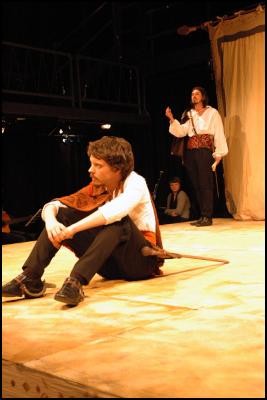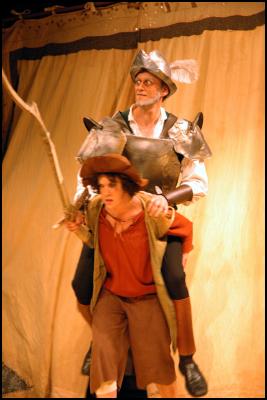Scoop Review: The History Of Cardenio
Scoop Review: The History Of Cardenio
Review by Lyndon Hood
Click to enlarge
Paul Waggot as Cardenio and Jonny Potts as Don Ferdinando
The History Of
Cardenio
By William Shakespeare and John
Fletcher
A creative reconstruction by Gary
Taylor
Directed by David Carnegie
Performed and
produced by students of THEA302
Designed by students of
THEA 324
Studio 77, 77 Fairlie Terrace, Kelburn (Gate 10
of Victoria University)
Tuesday 19 to Saturday 23 May
2009, 7.30pm
$8 unwaged $15 waged
To book: email
theatre@vuw.ac.nz
or call 04 463 5359
Part of the Cardenio Colloquium at Victoria University of Wellington and the New Zealand Compleate Workes festival.
It's
not often one gets a chance to review a new play by William
Shakespeare. On the other hand, what we have here isn't so
much a reconstruction of Shakespeare and Fletcher's lost work
as an enthusiastic punt at how it might credibly have been.
Or perhaps, the way we might wish it was. And as it turns
out, that's rather fun.
In 1613 The King's Men performed The History of Cardenio, which a later record attributes to William Shakespeare and John Fletcher. That play is lost. But in 1727 Lewis Theobald produced Double Falsehood, which he claimed was based on three manuscripts of an unknown Shakespeare play.
The fascination of Cardenio is not merely as a lost Shakespearian work. It's reasonable to suppose that it was based on the story of Cardenio in Cervantes’ Don Quixote. Shakespeare-does-Cervantes would make Cardenio the dream mashup of European literature. Although nobody ever saw Theobald's manuscripts, his play follows Cervantes’ story (with the names changed), and there is evidence his claims of provenance can be taken seriously.
The [present] play even contains sly references to this project. The Don Quixote character listens to the raving of a madman while reading an abandoned book full of sonnets and declares the madman to be the author of both: "The same style!" he says, nodding sagely. Someone trying to tease out various authorships in an ancient mongrel text might well feel sympathy with the Don, whose brain grew dry and cracked with the reading of too many books.
And now, as an ongoing project, Gary Taylor is trying to unpick Theobald's script and make a "creative reconstruction" of the original, drawing on Don Quixote to help fill the gaps. Many of the names are changed back to the originals (considering the varying number of syllables, fitting those into verse would have been an interesting exercise in itself). So to the authors headlined on the poster (Shakespeare, Fletcher and Taylor) we should probably add Cervantes and, one assumes, Theobald. It's probably a consequence of looking for seams that may or may not have been there, but I experienced the play more as a kind of layered collage than a reverse-engineering.
The design reflects this. The space is arranged as a jacobean theatre, with a raised stage thrusting into the audience, who also sit on balconies on all four sides (the front balcony also included a playing space), and live musicians at the side. Within this framework, everything except the costumes (more-or-less in period) is done as oversized patchwork. Huge stitches appear on the backdrop, all the props, even on the stage.
In the story as it stands (it has many of the names changed back to the original versions), Ferdinando, the young son of the Duke, abandons his promise to the commoner Violante and tries to marry Lucinda, the love of his friend Cardenio. It all ends badly and they run off into the mountains - Cardenio in madness, Lucinda to a nunnery, Ferdinando after Lucinda and Violante dressed as a shepherd boy. Also present is old Don Quixote (appropriately anglicised to "Don Quixot"), convinced he is a knight-errant, and Sancho, his servant. The Duke's older son Ricardo goes after Ferdinando and eventually wrangles them back to court, untangles the mess, and sees that the lovers end up marrying happily.
The "history" in the title seems odd, as if the authors didn't realise that Cervantes’ story about a man who took fiction too seriously wasn't real. It is a comedy of love, lust, betrayal, madness and redemption, with the dark edges of Shakespeare's later 'problem' plays. The structure is similar to The Winter's Tale: a setup that could as easily end in tragedy, the location of the play suddenly shifting to pastoral wilderness, and finally the guy whose badness caused all the trouble being redeemed through a trick.
It also has a number of elements - a distinctly unkind priest, abduction from a nunnery, a lecherous shepherd - seem to belong more to Fletcher and the Jacobean theatre than to Shakespeare. The last - a shepherd who recognises Violante as a girl and attempts to rape her - may be such an unpastoral idea as to belong to the later Theoblad. Violante is recognised as a girl a number of times, which seems odd in the context of Shakespearian convention and the comedy that normally arises from that device must be found elsewhere.

Click to enlarge
Christopher De Sousa Smith as Senor Quesada (Don Quixot)
and Kelly Irvine as Sancho
An obvious change from Theobald's text - based on the cast list - is the inclusion of a comic subplot with the character of Don Quixot. Presumably because this is just the kind of thing that Theobald would have excised, and exactly the sort of clown Shakespeare would have been unable to resist. The play manages to summarise the Don's story, while concentrating on the incidental part he plays in Cardenio's troubles. The dialogue often drew recognisably on Cervantes (which no doubt beats a deeper second-guessing of the Bard) and a feature part for a literary, delusional buffoon is, to my knowledge, a double novelty in Shakespeare. But it must be said that the part, in Chistopher De Sousa Smith's staring-mad performance, provided plenty of laughs and satisfied the desire to see Shakespeare and Cervantes side by side.
On the other hand, Sancho - the Don's servant boy, played by Kelly Irvine - stepped into Shakespeare like he was born there. Playing the tradition comic servant, wily-gullible, cowardly, earthy and hunger-driven, Irvine connected directly with the audience, undermining the knight-errant's pomposity, throwing in a few localised jokes or staying on at the end of a scene to set the world to rights.
The juiciest parts belong to the male leads. The title role of Cardenio (Paul Waggot) really gets interesting when he breaks up the attempted wedding then runs mad in the mountains. Waggot affectingly played that picturesque madness - Lear-ish (or at least Edgar-ish) shirts-off ranting which in this adaptation includes obscenity of a Shakespearian level and style (if not, arguably, quality). Waggot's raving allowed more range than Don Quixot's wide-eyed delusion - inducing pity earlier (and probably alarm for the audience near him on the balcony) and later using it to comic effect.
Jonny Potts plays Don Fernando, the treacherous friend and lover cruising for redemption. Of all the cast he seemed the most poised and ready to respond in the moment; a confidence and presence that was welcome after the opening scene, before his first entrance, had a jittery first night.
Kate Clarkin brought a bit of modern self-possession to the less prominent female role of Lucinda. As Violante, Elle Wooten ably covered a range of ground - jilted lover, faux shepherd-boy, a striking bit of singing and a fun comic turn in the efforts to humour Don Quixot's delusion out of existence.
I should note that at the beginning of the action Violante extracts a promise of marriage from Don Ferdinando and he immediately demands sex from her against her will - something I understand gets even more emphasis in Theobald's full text. The solution to this - apparently usual for Fletcher and not far from some things in Shakespeare - is to marry the victim to perpetrator, which wouldn't entirely satisfy a modern audience. In this production I felt it was something that could not be removed but that would hopefully be forgotten.
The rest of the many parts are shared by an able supporting ensemble. At the time of the original Cardenio all of the parts were played by men; the comedy of cross-dressing women was often enhanced by this. This production includes girls playing blokes instead. It makes the most of this when, plotting to trick Don Quixot into going home, the Barber (played by Angie Hagen) disguises himself with (another) fake beard while telling the Curate (Liam Atwood) to disguise himself as a damsel in distress.
Beards are actually something of a feature - there are various alarming fake beards (perhaps part of the stitched-together aesthetic); in this student production a number of young men play old ones through greasepaint and powdered beards. As far as I recall only the male leads had their own, undoctored facial hair.
The play closes with an epilogue. These are common in Shakespeare's comedies but Theobald does not supply one. Taylor's is delivered by Don Quixot and is amusingly reminiscent of Prospero's conclusion of The Tempest - he puts aside his book (the chivalric epic Amadis of Gaul) and begs the audience to release him from enchantment with their applause. We were all too happy to do so.
Author Gary Taylor will give an open lecture on 22 May as part of the Cardenio Colloquium at Victoria University of Wellington
- Press release - Full production of Shakespeare’s lost play
- Earlier - Shakespeare scholar to deliver lecture
- TV3 Video - 'Lost' Shakespeare play to have world premiere in Wellington
Students of THEA301 will perform Richard II by Shakespeare, 2 - 6 June.


 Richard S. Ehrlich: China's Great Wall & Egypt's Pyramids
Richard S. Ehrlich: China's Great Wall & Egypt's Pyramids Gordon Campbell: On Surviving Trump’s Trip To La La Land
Gordon Campbell: On Surviving Trump’s Trip To La La Land Ramzy Baroud: Famine In Gaza - Will We Continue To Watch As Gaza Starves To Death?
Ramzy Baroud: Famine In Gaza - Will We Continue To Watch As Gaza Starves To Death? Peter Dunne: Dunne's Weekly - A Government Backbencher's Lot Not Always A Happy One
Peter Dunne: Dunne's Weekly - A Government Backbencher's Lot Not Always A Happy One Richard S. Ehrlich: Cyber-Spying 'From Lhasa To London' & Tibet Flexing
Richard S. Ehrlich: Cyber-Spying 'From Lhasa To London' & Tibet Flexing Gordon Campbell: On Aussie Election Aftershocks And Life Lessons
Gordon Campbell: On Aussie Election Aftershocks And Life Lessons